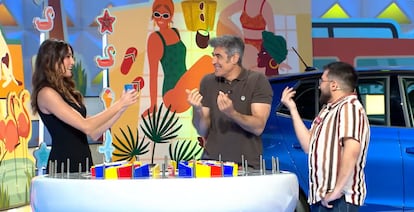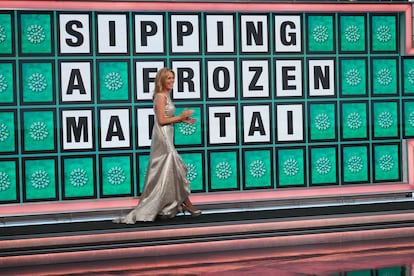Until well into the era of private channels in Spain, in the nineties, the hostesses were an important part of the television landscape: they collected balls from the Telecouponhelped with the numbers in the One, two, three…accompanied Jesús Gil in his pool and danced like mother boys (archetypes of Italian television). They also performed banal tasks such as carrying an envelope or showing the product of a The right price. But “hostess” is a term that does not fit into television in 2024. And The wheel of fortuneone of the daily spaces with the highest audience on the small screen and one that has been on the air since the nineties, has made its own journey.
In 2015, Antena 3 introduced Laura Mouré as a “hostess” in her first program in front of the panel, but, aware that this position is no longer something that is well accepted (they have also been withdrawn with controversy from multiple sporting events), Atresmedia has presented her for a couple of years always as co-presenter. “Before, what was known as a hostess or stewardess had an auxiliary mission, to carry out a specific task. Laura and Jorge [Fernández, el presentador] “They maintain a complicity with the viewer and offer dynamism,” defends Esther Pérez, manager of Entertainment Programs at Atresmedia TV, in a questionnaire, who details the specific tasks that Moure has been taking on: “Laura presents the beginning of the program and says goodbye, participates in the final test and reveals her prizes, comments on the panels and any anecdote or moment with Jorge. In short, she is an active and necessary member, with an essential role in the development of the contest. She brings dynamism and forms a tandem that the audience loves.”
Television analyst Mariola Cubells questions this version and believes that “Moure’s role is an obvious anachronism and fortunately something quite unusual right now.” Cubells argues that, in addition to her interaction at very specific and measured points, “the role of co-presenter should be more active, very different from what she does.” Above all, also, because her main task was surpassed by technology since the format arrived at Antena 3 in 2006. The letters on the panels of The wheel of fortune They no longer turn by touch. A person in control presses a button to make them turn digitally. Despite this, an actress and model (from 2006 to 2015, Paloma López played the role) continues to walk from corner to corner so that on screen it seems that she solves the hidden phrases. Although the trick is sometimes noticeable on screen (and reflected on social networks), the game is part of the magic of television. But her walks around the panel remain today almost as a vestige of another era and another way of making programs.
Carme Ferré-Pavia, a professor of Communication at the Autonomous University of Barcelona, expresses her astonishment at Moure’s role in the programme: “It seems old-fashioned to me. They almost did more in the One, two, three. I don’t like to say these things, but sometimes it seems like she’s there just to show off. Is that role necessary? Does the show always have to stick to the same beauty standards to be attractive? We’re still playing with entrenched stereotypes. I put it in black and white and it’s old.” That’s why the people in charge of the contest that is broadcast daily have been expanding Moure’s role, and that is no longer her only task, although these are functions that are still complementary. The right pricewhich produced hostesses such as Beatriz Rico, Pilar Rubio and Yvonne Reyes, also reconsidered this evolution in its last seasons. The Telecinco edition was careful to have both women and men playing the role, and, in addition, they interacted more and more with the presenter and the contestants. It gave a bad image that they were there only for their pretty faces, because their role takes us back to a time when the programs were populated by hostesses.
Ferré-Pavia, researcher of the 2020 study The role of women in infotainment programmes in Spain: the resistant glass ceilingalso believes that the problem is somewhat broader, even though the role of stewardess as such has disappeared: “Today it is strange, but if you scratch a little and see the numbers, the appearances of men are still much higher and attributes such as clothing, makeup and their role are different according to gender. Sometimes women play a kind of maternal role. Men have the role of leaders and women, of assistants, as in The Intermission. Fortunately, now when there is a slimy attitude it is criticized.”

Antena 3 argues that the complicity between presenter and co-presenter is precisely part of the undoubted success of the team The wheel of fortune. Pérez argues: “Although Jorge carries the weight of the program, as the main presenter, it is clear to the viewer that Laura is the co-presenter, with her space and style. The success of The wheel of fortune “The advantage of this is that, despite being such an old format, it has adapted to the times without losing its playful essence and its good tone,” she says, aware that her role had to change: “Laura’s role and degree of participation have evolved.” Other parts of the format have also evolved, such as the music.
Presenter at 67 years old, a rare bird
The United States is another very particular case. In the contest there are still hostesses who resolve the panels, yes, but she is one who has been allowed to age on screen. The person in charge is called Vanna White and from her panel she has witnessed the evolution of television in the last four decades. She has been in her position since 1982, and has only been absent from 10 programs. Last July, her version of Roulette surpassed a milestone. The presenter, Pat
Sajak, said goodbye after 41 years on the air; she, a former miss who has been co-presenting for more than four decades will, however, remain on air at 67 years of age.
Not only is she a star in her own right, but at her age she represents a model of womanhood that is not so common in these formats. She is not just another young hostess. With her experience, her role has also become more active and, when the main host fell ill or had to be absent, she filled her place as presenter. Curiously, then Sajak’s very young daughter would appear in front of the panel, who has now taken on the role of social media correspondent, created for her.

Could Moure end up taking on those roles? “The mechanics leave little room. In a successful format, the margin for innovation is narrower,” Pérez admits. “Despite that, over the years we have been introducing many changes to the game dynamics. The complicity and chemistry between Laura and Jorge and their closeness to the contestants have led to Laura becoming more and more prominent. The same goes for the band, which might have the sole function of playing, but actively intervenes in the development. She brings closeness and is a familiar face to the public. Laura, who knows the format so well, would be a great presenter.” Roulette”.
Ferré-Pavia is confident that further steps will continue to be taken in this evolution: “Be careful with the message you send when, in the era of artificial intelligence, you have a girl in a miniskirt with skinny legs circling a panel, like a flowerpot woman,” she warns. Cubells points out that, even so, the problem goes far beyond this contest, and assures that “television continues to be crueler to women than to men, in terms of aesthetics, age, representativeness… It has become stale, but it is still very masculine.” She is, however, “optimistic,” because she has witnessed how things have changed in this regard (“if we compare, it is bliss”) and she knows that today there are critical voices that highlight the “faults and traps.”
What White has perfected, for example, in these 40 years in the US is applause. So much so that in 2015 got the Guinness record of the person who has applauded the most in history: 3.7 million times during 32 seasons, 606 applauses per program. A very classic task for hostesses. To avoid these mannequin attitudes, in 2020 RTVE approved, through its Equality Observatory, a guide in which he advocated for, among other things, “avoiding the objectification of the female body” and said that “we will try not to prioritize women’s physical attributes over their intellectual ones.” Also for not promoting “a model of feminine beauty based on youth, thinness or physical perfection, according to unrealistic standards.” Precisely the text reads like a departure from the classic image of flight attendants.
“If you want to change things, it has to be from the top, from management,” says Ferré-Pavia, who points to ageism as another of the problems of television: “It is a very obvious mistreatment. They should be allowed to grow old in peace, and everyone should be treated equally.” Cubells confirms these shortcomings: “How many women over 50 years old present news programmes? Hardly any. Men can be normative or overweight, and women cannot. As in society, they have to conform to the norms of femininity. That is why I am glad that RTVE is recovering its role as a presenter of news. 59 seconds with Gemma Niega [de 58 años]There are no women in contests or in major television programs. prime time entertainment. There are no ugly women either,” he stresses: “Television sends messages all the time and educates the gaze.” Atresmedia, which for years had Silvia Jato on its show Pasapalabraremembers her effort to place presenters in contests: Cristina Pedroche in Password; Ana Pastor in Top Generation; and Nuria Roca in Family FeudThis season, Luján Argüelles presents The weakest rival on Telecinco.
Because The wheel of fortune It is undoubtedly an open window to everyone, one of the most consistent successes of television. This year, the program broadcast by Antena 3 for 18 seasons has averaged a 21% audience share and 1.6 million viewers, the highest in 15 years. And this is despite the fact that the format is one of the oldest on Spanish television. It began in 1990 with private channels and precisely with a woman, Mayra Gómez Kemp, as presenter. A diverse group of presenters has passed through its podium, such as Ramón García, Irma Soriano, Bigote Arrocet and Mabel Lozano, Belén Rueda, Fernando Esteso, Jesús Vázquez, Andoni Ferreño, Goyo González and Carlos Lozano, in 1997. Afterwards, it went on a nine-year hiatus until its return in 2006, with the panels renovated and already autonomous. But there was still a model that walked to the rhythm of “I buy the A and I solve it.”
You can follow EL PAÍS Television on X or sign up here to receive our weekly newsletter.
#case #Wheel #Fortune #role #hostesses #sense